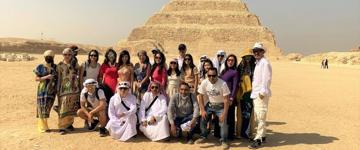Alhambra
The Alhambra is a palace and fortress complex of the Moorish rulers of Granada in southern Spain (known as Al-Andalus when the fortress was constructed during the mid 14th century), occupying a hilly terrace on the southeastern border of the city of Granada.
Once the residence of the Muslim rulers of Granada and their court, the Alhambra is now one of Spain's major tourist attractions exhibiting the country's most famous Islamic architecture, together with Christian 16th century and later interventions in buildings and gardens that marked its image as it can be seen today.
The Alhambra was so called because of its reddish walls (in Arabic, ("qa'lat al-Hamra'" means Red Castle). It is located on top of the hill al-Sabika, on the left bank of the river Darro, to the west of the city of Granada and in front of the neighbourhoods of the Albaicin and of the Alcazaba.
The castle of the Alhambra was added to the city's area within the ramparts in the 9th century, which implied that the castle became a military fortress with a view over the whole city. In spite of this, it was not until the arrival of the first king of the Nasrid dynasty, Mohammed ben Al-Hamar (Mohammed I, 1238-1273), in the 13th century, that the royal residence was established in the Alhambra. This event marked the beginning of the Alhambra's most glorious period.
From the time of the Catholic Monarchs until today we must underline that Charles V ordered the demolition of a part of the complex in order to build the palace which bears his name. We must also remember the construction of the Emperor's Chambers (habitaciones del Emperador) and the Queen's Dressing Room (Peinador de la Reina) and that from the 18th century the Alhambra was abandoned. During the French domination part of the fortress was blown up and it was not until the 19th century that the process of repairing, restoring and preserving the complex started and is still maintained nowadays.
The greatest concern of the architects of the Alhambra was to cover every single space with decoration, no matter the size of the space. No decorative element was enough. Most of the interior arches are false arches, with no structure; they are there only to decorate. Walls are covered with beautiful and extremely rich ceramics and plasterwork. And the coverings have wooden frames that have been exquisitely carved, etc.
Even though the Muslim art bans the representation of figures, the decorating themes in the Alhambra are quite varied. The classical calligraphic decoration is used, in particular cursive and kufic inscriptions, which reproduce the words of Zawi ben Ziri (founder of the Nasrid dynasty): "Only God is Victor", and poems written by different poets of the court.
The decorative elements most often used by these architects were stylised vegetal forms, interlacing decoration and the nets of rhombuses.



